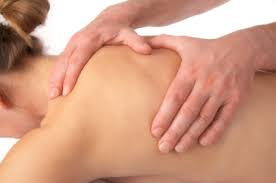The shoulder is responsible for a wide range of motions, and any problem in shoulder joint can cause severe discomfort and restriction of movements. Most of the times, shoulder pain is due to soft tissue injury. The muscles, tendons and ligaments can be damaged by overuse. There are also many diseases which can damage the shoulder joint, leading to pain in shoulders.
Causes and Medical Treatment of Pain in Both Shoulders
1. Osteoarthritis
This is the most common type of arthritis. It leads to destruction of the cartilage which covers the end of bones. The cartilage acts as a cushion to prevent the bones from rubbing against each other. When this cartilage is damaged, there is increased friction between bones, so the joint becomes swollen, stiff and painful. The osteoarthritis of shoulder joint often follows an injury.
Treatment:
There is no effective way of reversing the damage caused by osteoarthritis, but the symptoms can be successfully managed by medication, physical therapies, lifestyle changes and surgery. Exercising and maintaining a healthy body weight are the most effective ways to control this condition.
2. Rheumatoid Arthritis
This chronic inflammatory disease can also affect the shoulder joints. It is an autoimmune disease in which the body falsely identifies the lining of the joint surfaces (synovium) as a foreign object and starts to attack it. This leads to inflammation and swelling of the joint, causing pain and loss of function. If one shoulder is affected, the other shoulder will be affected too.
Treatment:
The permanent cure for rheumatoid arthritis is yet to be found. Disease modifying drugs (DMARDs) are effective to control symptoms if started at an early stage.
3. Gout
Deposition of uric acid crystals in body tissues and joint can lead to gout. Uric acid is a waste product and circulates in blood, when there is excessive uric acid production, it gets deposited in the tissues in the form of needle shaped crystals. When these are deposited in joints, they cause excruciating pain and swelling of the joint. Shoulder joints can be affected by gout in some cases.
Treatment:
Gout is generally treated by nonsteroidal anti-inflammatory drugs (NSAIDs), corticosteroids and colchicine.
4. Pseudogout
Pseudogout is also caused by crystal deposition in the joints, but these crystals are formed from calcium pyrophosphate dihydrate. There is pain and swelling of the involved joints which often appear at night time. The knee, wrist and shoulder are most commonly affected by pseudogout.
Treatment:
There is no cure available for psudogout. Over the counter pain killers can be used to control the pain, and more severe symptoms respond well to nonsteroidal anti-inflammatory drugs (NSAIDs), corticosteroids and colchicine.
5. Lupus
Lupus is an autoimmune disorder in which the body produces antibodies against its own tissues, causing inflammation and damages. It can affect skin, lungs, kidneys, heart and joints. This disease can cause inflammation of muscles around the shoulders, leading to pain in both shoulders.
Treatment:
The mainstay of treatment is to control the symptoms and slow down the disease progression. Antimalarial drugs, immunosuppressant drugs, and corticosteroids are the most commonly used medications.
6. Rotator Cuff Damage
The group of tendons and four muscles that connect the arm to the shoulder is called the rotator cuff. Inflammation, injury or bruising of the rotator cuff can lead to a painful shoulder. The pain is worst while sleeping on the affected side, moving the arm over head or behind the back.
Treatment:
Painkillers and ice packs are effective to control the pain. Physical therapy is very effective, and in severe cases, a corticosteroid injection inside the joint cavity is recommended.
7. Bursitis
The inflammation of the bursa is termed as bursitis. Bursas are the little fluid filled sacks present around the joints. These tiny cushions prevent friction and act as shock absorbers. Shoulder pain caused by bursitis is a dull ache that can be aggravated by moving the arm upwards or sideways.
Treatment:
Rest is the best treatment option for bursitis. If the pain is severe, a cortisone injection can reduce the inflammation. Surgery is recommended when the pain is not getting better after physical therapies and cortisone injection.
8. Dislocated Shoulder
When the upper arm bone gets dislocated and gets out of the shoulder joint socket, you will feel excruciating pain in the shoulder. There can also be swelling, bruising or numbness of the arm and the shoulder.
Treatment:
The dislocated bone is manually maneuvered back into the shoulder joint socket under mild anesthesia. Wearing a sling for a few weeks after the correction to immobilize the shoulder joint is advised to prevent the recurrence and avoid any further damage.
9. Frozen Shoulder
A frozen shoulder or adhesive capsulitis results from the inflammation and thickening of the lining of the shoulder joint. A frozen shoulder has three stages: During the first stage, the range of movements decrease and there is severe pain; in the next stage, the pain is considerably less, but the stiffness and restriction of movements is maximum; during the final stage, the stiffness and pain gradually get better.
Treatment:
It takes 12 to 18 months to go through these three stages and eventually the joint will get better. Pain killers, physical therapies and ice packs are helpful to alleviate the pain. In severe cases, a local injection of corticosteroids is recommended to increase the range of movements.
Home Remedies for Pain in Both Shoulders
There are some very effective home remedies for shoulder pain, but if you have persistent pain, you'd better seek medical advice and get treatment for underlying causes.
1. Cold Compress

Application of a cold compress can provide relief if you have shoulder pain. The cold temperature makes the area numb and reduces inflammation. You can either put some ice cubes in a bag, wrap it in a cloth and then put on the aching joint, or soak a towel in cold water for some time, remove extra fluid and wrap around the shoulder for ten to fifteen minutes.
2. Hot Compress

Hot compresses also help reduce pain, stiffness, inflammation and swelling. It is best to use a hot compress 48 hours after an injury. You can do this by applying a hot water bottle on your shoulder for 10-15 minutes. The heat helps to relax the muscles and reduce the pain greatly.
3. Epsom Salt Bath

Add two cups of Epsom salt in a hot water bath and soak yourself for 20-25 minutes. Epsom salt is very effective to relax stressed muscles and improve blood circulation. If you have pain in both shoulders, try an Epsom salt bath three times a week to ease the pain.
4. Massage

Massage is another effective way to sooth the stretched muscles. Besides, it also improves blood circulation, reduces stiffness and swelling. You can either get a massage from professional massagers or do it by yourself. Use olive oil, coconut oil or mustard oil, warm the oil up a little and massage the affected shoulder for about ten minutes. Wrap the shoulder in a warm towel afterwards for best results.
When to See a Doctor
You should seek medical advice immediately if you have the following symptoms:
- Severe pain
- Deformed looking joint
- An inability to move the arm in any direction
- Difficulty in breathing
- Tightness in the chest
